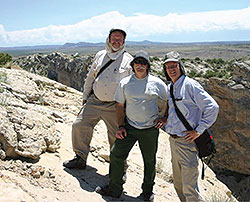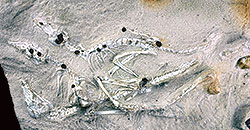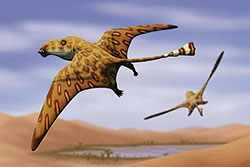 |
| From right to left: Brooks Britt (BYU), Dan Chure (Dinosaur National Monument) and George Engelmann (University of Nebraska) at the Saints and Sinner’s Quarry, source of one of the most important early Mesozoic fossil sites discovered in recent decades. It yielded a mere 22,000 bones. |
If you followed Happenings recent pieces on People in Paleo you saw Dino Jim Kirkland, current Utah State Paleontologist, featured last month (Moab Happenings July 2022). Like all this year’s featured paleo superstars, all of whom are researchers in the Dinosaur Diamond, he shares something in common with one of this month’s paleo celebrities, Brooks B. Britt (BBB), currently a professor at BYU. BBB @ BYU cut some of his paleontological teeth, for 5 years, as Curator at the Museum of Western Colorado (MWC) before he escaped to Utah. Stay tuned for next month’s story of another MWC curator who escaped to Utah! This trend is perhaps explained by most of the Dinosaur Diamond being in Utah, not Colorado: see People in Paleo (Moab Happenings June 2022) for another escapee.
So, who is this BBB guy, who claims to have been digging dinosaurs since he was 14 when he first found a giant sauropod? Well, he is another dino-digger magnetically drawn to the bone-rich Morrison Formation (Upper Jurassic) and Cedar Mountain Formation (Lower Cretaceous). His claim to fame, in the Moab area, comes from naming Moabosaurus utahensis, from a site in what is now the new Utahraptor State Park: (Moab Happenings Aug. 2021). You may be saying, correctly, that this new dino park, is getting a lot of press even before it is open. That’s because it has yielded so many dinosaurs: over 5,500 in fact, most of which had been trampled and broken by other dinosaurs which had no respect for their recently departed brothers and sisters. To add insult to injury the bones were also chewed by lowly, bone-loving beetles.
 |
| Three skeletons of rare 200-million-year-old (Late Triassic) crocodile relatives known as sphenosuchians from the Saints and Sinners Quarry at Dinosaur National Monument. Black spots are mineral deposits. Photo courtesy of Utah Geological Association. |
But though you may, again correctly, say that one could contribute stories on such 125-million-year-old fossils from around Moab for the next 125 million years and not run short of material, it is time to depart for a different time and place: near what is now Dinosaur National Monument in the Late Triassic Epoch, about 200 million years ago. Here BB Britt and his colleagues, including Dan Chure, who was Dinosaur National Monument’s paleontologist for 38 years, described a truly remarkable treasure trove of beautifully preserved small skeletons. This was not, we must repeat NOT, from the world famous, 150-million-year-old bone quarry (Moab Happenings Feb 2022). Rather, this discovery, made by Dan and another colleague, George Engelmann, in 2008, revealed the remains of a eight reptile species mostly new to science: these included two dinosaurs, two crocodilians, and two lizard-like species as well as a pterosaur. At this site named the “Saints & Sinners Quarry”, more than 22,000 bones were excavated from an area the size of a large living room. Exposing them with the help of small pneumatic jackhammers the size of pencils, known as “air scribes” (think of your dentist) was described as “painfully slow.” In fact, it has taken years to excavate and describe, but as BB Britt told me they are rare motherlode “discoveries-of-a-lifetime.” This “bone bed” area represented a small interdune
 |
| Reconstruction of pterosaurs flying around a 200-million-year-old desert oasis environment: based on finds of the new species Caelestiventus hanseni from the Saints and Sinner’s Quarry. Courtesy of Nix Illustration. |
oasis in a giant sand sea or “erg” that dominated most of Utah and stretched from what is now southern California to Wyoming. For comparison, think of the famous fossil dunes of the Navajo Sandstone at Arches or Lake Powell. Because such skeletal remains are “extraordinarily rare” (to quote Britt and Chure) we once thought such ancient sandy deserts devoid of life, but tracks prove otherwise, especially in the interdune areas, where animals were attracted to water and where they left clear tracks. Dan Chure and friends described tracks of mammal-like species and even large spiders that once roamed these deserts. He is also obscurely famous for once saying: “a species cannot get any more endangered than already being extinct.” But that’s why paleontologists earn big bucks for preserving their remains!
|